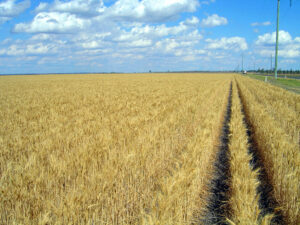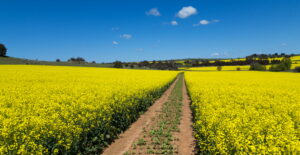Wheat prices have been falling since the start of the year. With a bumper crop in Australia destined for export markets, there is little support for local values in the face of declining US values. Here we look at taking advantage of weaker values to protect against lower supplies and higher prices in 2023-24.
When a big wheat crop in Australia has to be exported, prices generally track near to, or lower than the US benchmark; Soft Red Wheat (SRW) futures. Figure 1 shows how ASX Wheat Futures, based on Australian Premium White (APW) on the east coast, have performed, along with SRW futures.
The recent fall in SRW futures was driven by bumper crops here in Australia and Russia which alleviated some of the global supply concerns. Consequently, this has seen ASX wheat futures also slip under $400/t. The weaker US dollar has also seen values here decline, as our prices need to be cheaper to compete in international markets.
East coast wheat hasn’t been this cheap since March last year, and lower prices are good news for consumers.
International wheat prices are now back at the levels we saw pre-war in Ukraine. The war is still supporting prices, as there is always the chance trade from the Black Sea will close again. Issues with corn and soybean crops in South America, and the upcoming planting season in the US are also supporting values.
Figure 2 shows the ASX spread to SRW, and it’s slightly negative at the moment. It is, however, less negative than during the height of the war-induced price rallies in the US.
If we look back at 2017 and 2018, when there were much smaller crops, we can see how local price spreads can blow out relative to SRW. It’s currently hard to comprehend a premium of $175/t when we are awash with wheat, but we will see it again.
After three bumper crops, some would say we might be due for the dreaded El Niño, but consumers can protect themselves.
Last week ASX Wheat Futures for Jan 24 closed at $384/t. Current Dec 23 SRW Futures sit at around $405/t in our terms. Buying Jan-24 at a $20 discount to SRW looks like reasonable value, given our crop isn’t even in the ground.
What does it mean?
The risk in buying ASX Jan -24 futures is that falling wheat prices would see a payout on futures. But then there is some compensation for buying cheaper physical wheat. This is ok if you are happy with wheat prices under $400. The benefit comes if there is a price rally on international or local markets, which leads to wheat becoming more expensive. The profit from futures helps fund purchases of the more expensive wheat.
By buying ASX wheat and selling SRW you can lock in the negative spread. This means that to profit from futures, ASX wheat has to rise relative to SRW. Good for drought protection, but the risk is another left-field driven SRW rally as we saw in March last year, which leaves the ASX way behind.
Have any questions or comments?
Key Points
- ASX Wheat futures are under $400/t for the first time since March 2022.
- Weaker global markets have driven Australian prices lower.
- Jan-24 ASX Futures are also low, opening hedging opportunities for consumers.
Click on figure to expand
Click on figure to expand
Data sources: CME, ASX, Refinitiv, Mecardo














